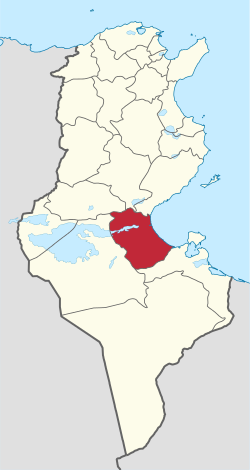Gabès Governorate
Gabès
ڨابس Gabis | |
|---|---|
 Map of Tunisia with Gabès highlighted | |
 Subdivisions of Gabès Governorate | |
| Coordinates: 33°53′N 10°07′E / 33.883°N 10.117°E | |
| Country | |
| Created | June 1956[1] |
| Capital | Gabès |
| Government | |
| • Governor | Radhouane Nsibi (since 2024) [2] |
| Area | |
• Total | 7,166 km2 (2,767 sq mi) |
| • Rank | Ranked 8th of 24 |
| Population (2014) | |
• Total | 374,300 |
| • Rank | Ranked 16th of 24 |
| • Density | 52/km2 (140/sq mi) |
| Demonym(s) | Gabesian (Arabic: قابسي, Gabsi) |
| Time zone | UTC+01 (CET) |
| Postal prefix | 60xx |
| Calling code | 75-2/75-3 |
| ISO 3166 code | TN-81 |
Gabès Governorate (Tunisian Arabic: ولاية ڨابس Wilāyat Gābis; French: Gouvernorat de Gabès) is one of the 24 governorates of Tunisia and in south-eastern Tunisia. It covers an area of 7166 km2[1] and had a population of 374,300 as at the 2014 census.[3][4] The capital is Gabès.
Geography
[edit]The governorate of Gabès is in southeast Tunisia on the coast of the Gulf of Gabès, 376 km south of the capital, Tunis.
Gabès has a hot Mediterranean climate. Gabès offers five contrasting landscapes: the beach, the mountains, the desert, small forest, oasis. It contains the eastern end of Chott el Fejej.
The coast is approximately half of that of the large bay. The gulf has several alternative names dating to antiquity and to an etymological association with onshore winds and sandbanks making navigation difficult, including Lesser Syrtis (see Gulf of Sidra which takes in also the mainly Libyan portion of the continental gulf).
Economy
[edit]Despite the growing development of the industrial sector, farming remains the dominant activity in the governorate.[5]
In last few decades, many chemical plants have been built in Gabès, mainly for processing and producing phosphate, phosphoric acid, diammonium phosphate and dicalcium phosphate.[6]
Gulf of Gabès is one the richest fishing areas in Tunisia.[7]
The governorate has three industrial zones: Gabès, Métouia-El Aouinet and El Hamma.
Since 1972, Several phosphate fertilizer plants have been built in the industrial complex of Gabès, utilizing the resources of the Gafsa mines. In 2013, following the deaths of two children from radiation-related illnesses, protests erupted in the Gabès District, demanding a reduction in phosphate pollution. Activists also launched online campaigns to raise awareness and engage with the government in efforts to address the issue.[6]
Administrative divisions
[edit]Administratively, the governorate is divided into ten delegations (mutamadiyat), ten municipalities, nine rural councils, and 73 sectors (imadas).[1] The delegations and their populations from the 2004 and 2014 censuses,[3] are listed below:
| Delegation | Population in 2004 | Population in 2014 |
|---|---|---|
| El Hamma | 62,390 | 73,512 |
| El Metouia | 25,862 | 27,878 |
| Gabes Medina | 47,057 | 46,731 |
| Gabes Ouest | 28,389 | 31,768 |
| Gabes Sud | 61,699 | 74,422 |
| Ghannouch | 22,681 | 28,051 |
| Menzel El Habib | 11,477 | 10,148 |
| Mareth | 61,340 | 63,122 |
| Matmata | 5,766 | 4,444 |
| Nouvelle Matmata | 15,969 | 14,224 |
Ten municipalities are in Gabès Governorate:
| Code | Municipality | Population (2014)[8] |
|---|---|---|
| 5111 | Gabès | 130,984 |
| 5112 | Chenini Nahal | 14,803 |
| 5113 | Ghannouch | 28,051 |
| 5114 | Métouia | 10,716 |
| 5115 | Oudhref | 9,932 |
| 5116 | El Hamma | 41,607 |
| 5117 | Matmata | 1,847 |
| 5118 | Nouvelle Matmata | 7,526 |
| 5119 | Mareth | 11,678 |
| 5120 | Zarat | 5,627 |
Tourism
[edit]Matmata is a Berber-speaking town largely of underground homes conserved with a community-based pre-industrialized lifestyle. The south-centre of the Wilāyat has semi-desert mountains and natural features nearby include splendid oases and caves. Eclectic souqs feature in the main municipalities, with traditional wood, stone, metal and textile products.
References
[edit]- ^ a b c (in French) "tunisieindustrie.nat.tn". Archived from the original on 2014-12-19.
- ^ https://www.tap.info.tn/en/Portal-Top-News-EN/17861830-president-of-the
- ^ a b "2014 Tunisian census data". Archived from the original on 2015-05-18.
- ^ (in French) Census 2014 (National Institute of Statistics) Archived 2014-10-29 at the Wayback Machine
- ^ "Environmental Impact Assessment for Nawara Construction Project of the Gas Treatment Plant of Gabès" (PDF).
- ^ a b "Gabès Phosphate Fertilizers Plants of the Tunisian Chemical Group, Tunisia". ejatlas.org. Retrieved 2024-11-18.
- ^ Ghaouar, Hana; Boussellaa, Wiem; Jribi, Imed (January 2024). "Ghost Gears in the Gulf of Gabès: Alarming Situation and Sustainable Solution Perspectives". Sustainability. 16 (7): 2632. doi:10.3390/su16072632. ISSN 2071-1050.
- ^ Recensement Général de la Population et de l'Habitat 2014 – Population, logements et ménages par commune et arrondissement [Census 2014 results – population, accommodation and households per municipality and delegation] (Report) (in French). National Institute of Statistics. 1 April 2015. Retrieved 18 February 2016.

